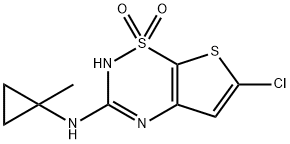279215-43-9
 279215-43-9 結(jié)構(gòu)式
279215-43-9 結(jié)構(gòu)式
基本信息
化合物 TIFENAZOXIDE
6-氯-3-[[1-甲基環(huán)丙基]氨基]-4H-噻吩并[3,2-E]-1,2,4-噻二嗪1,1-二氧化物
tifenazoxide
NN414 >=98% (HPLC)
NN 414 - Tifenazoxide
6-Chloro-3-[[1-methylcyclopropyl]amino]-4H-thieno[3,2-e]-1,2,4-thiadiazine 1,1-dioxide
2H-Thieno[3,2-e]-1,2,4-thiadiazin-3-amine, 6-chloro-N-(1-methylcyclopropyl)-, 1,1-dioxide
8-chloro-N-(1-methylcyclopropyl)-2,2-dioxo-2$l^{6},9-dithia-3,5-diazab icyclo[4.3.0]nona-3,7,10-trien-4-amine
物理化學(xué)性質(zhì)
常見(jiàn)問(wèn)題列表
K ATP channels
Tifenazoxide (NN414) hyperpolarises βTC3 cell membranes, and inhibits insulin release from βTC6, from isolated rat islets and from human islets at least a 100-fold more potent than Diazoxide.
The EC
50
values for Tifenazoxide and diazoxide are 0.45 and 31 μM, respectively in the patch-clamp assay. Tifenazoxide (100 μM) activates Kir6.2/SUR1 channels, but not Kir6.2/SUR2A or Kir6.2/SUR2 channels, expressed in Xenopus oocytes both in whole-cell and inside-out macropatch recordings.
Tifenazoxide is a potent inhibitor of glucose stimulated insulin release from βTC6 cells (IC
50
= 0.15 μM).
Tifenazoxide (NN414; 1.5 mg/kg; oral administration; twice daily; for 3 weeks; male VDF Zucker ( fa/fa ) rat) treatment for 3 weeks in VDF rats reduces basal hyperglycemia, improves glucose tolerance, and reduces hyperinsulinemia during an oral glucose tolerance test (OGTT) and improves insulin secretory responsiveness ex vivo.
| Animal Model: | Male Vancouver diabetic fatty (VDF) Zucker rat |
| Dosage: | 1.5 mg/kg |
| Administration: | Oral administration; twice daily; for 3 weeks |
| Result: | Basal glucose was significantly reduced with the fall averaging 0.64 mM after 3 weeks of treatment. |